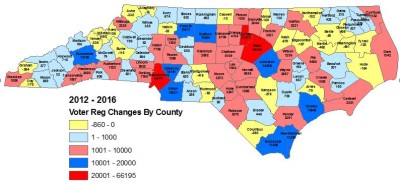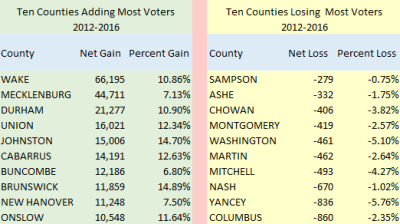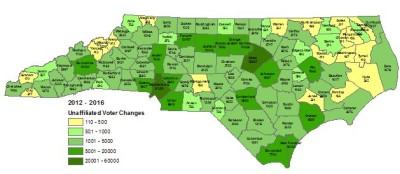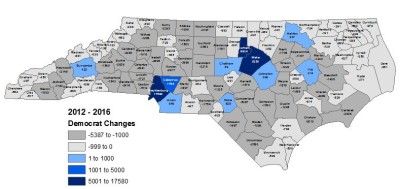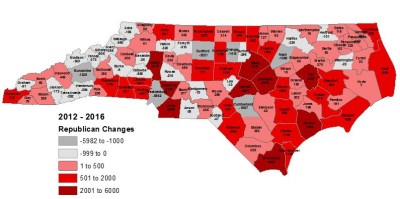NC's voter registration upheaval (2012-1016)
Published August 15, 2016
by Susan Myrick, Civitas Institute, August 11, 2016.
While talking heads say North Carolina is going from a reliably red state to a purple or blue state, the reality on the ground in North Carolina actually looks different. Although North Carolina may have been reliably Republican in presidential races leading up to the 2008 election, there is a legitimate question as to whether recent presidential election outcomes have been more personality driven or voter driven.
When we examine registration data and facts on the ground, we actually see the state trending more red – especially in down-ticket races – that until 2010 had been safely held by Democrats.
If you listen to North Carolina’s mainstream media, you may not realize that our state has experienced major voter registration shifts since the 2012 General Election. While political consultants, candidates and the media would have you believe that North Carolina is becoming more of a toss-up state, voter registration numbers combined with past election results tell a different story – one that may not fully be told until the ballots are totaled up this November.
In 2012, four years after then-Sen. Barack Obama won North Carolina by just over 14,000 votes, North Carolinians exercised their version of a “recall election” and put Mitt Romney over the top with a nearly 100,000-vote edge. During the same election, North Carolina voters elected only the third Republican governor and second Republican lieutenant governor since Reconstruction and solidified the 2010 Republican victories in the legislature by giving both chambers veto-proof majorities. The 2010 victories were significant in themselves, as Republicans had never before held majorities in both chambers at the same time and only briefly held the majority in the House for four years, from 1995-1998.
More importantly, the 2010 victories were won in maps drawn by Democrats – not Republican-friendly maps.
The election story being told by the Left and the media is that gerrymandering has distorted the outcome of elections. Since that applies mostly to the legislature, it is revealing to look at what is happening at the county commission level. Since 2008 Republicans have increased their control of county commission boards from 36 to 52 after the 2014 election. The number of elected Republican county commissioners has increased from 221 to 304 while the number of Democrats has decreased from 350 to 275.
Such results strongly suggest a change in voting pattern at the local level, a trend that undercuts the claims attributing Republican success in state legislative races to “gerrymandered” districts.
In light of media and political consultants’ portrayal of North Carolina’s political direction, the changes in voter registration numbers since 2012 are surprising. Since July 2012, North Carolina has seen a net gain of 347,252 voters. Broken down by party (or non-party for that matter), the number of unaffiliated voters has grown by a whopping 361,575 voters, Democrats have a net loss of 72,919 voters, Republicans have added 44,198 voters, and the Libertarian Party has grown by 14,398 voters.
Wake County led the way in adding new voters over the four-year period with a gain of 66,195 voters – a nearly 11 percent increase to that county’s 2012 voter registration numbers. Mecklenburg County added 44,711 voters to its 2012 total, upping that number by 7.13 percent.
Columbus County was the biggest loser, seeing a net loss of 860 voters – 2.3 percent of its July 2012 total – followed by Yancey County, which lost 836 voters, or 5.75 percent of its 2012 voter registration totals.
Unaffiliated – Voter Explosion
Many people believe that North Carolina is a battleground state and if so, then unaffiliated voters are critical to a winning campaign. Given that the state has added more than 361,000 voters to the unaffiliated ranks in the last four years, and that this bloc makes up more than 29 percent of the electorate, the stakes (and suspense) intensify. The increase in North Carolina voters who opt not to choose a party affiliation is part of a pattern of voter registration that began in January 2009 and escalated after the 2012 election. Voters angered/disappointed/disillusioned with both political parties seem to be comfortable with their unaffiliated status. It helps that in North Carolina unaffiliated voters are eligible to vote in any party’s primaries.
All of North Carolina’s 100 counties experienced a net gain of unaffiliated voters in the last four years. Two counties’ unaffiliated counts went up by more than 20,000 voters. Wake County leads in this category too, increasing its unaffiliated voter numbers 50,907 voters. Wake is followed by Mecklenburg, which saw a net gain of 31,328 unaffiliated voters in the last four years. Sixteen counties experienced net gains between 5,000 and 19,000 of voters that chose the unaffiliated ranks. Fifty counties had net gains from between 1,000 and 4,999 unaffiliated voters, 13 counties had net gains of between 500 and 999 unaffiliated voters, and 19 counties increased their unaffiliated numbers from between 110 and 499 voters.
Democrat Party – Ominous Decline
There is not much good news for the Democrat Party when it comes to voter registration in the last four years. Democrats have been losing ground in North Carolina since 1993, when the National Voter Registration Act (NVRA) was signed into law by former President Bill Clinton. Widely known as the “motor voter” law, it allowed people to register at the Department of Motor Vehicles when they got their drivers licenses and at other government agencies as well. While Democrats claimed the NVRA was needed to make registering to vote easier and would open the process up to more people, in North Carolina it cleared the way for voters to register in parties other than the dominant Democrat Party.
Democrats had ruled county commissions, the legislature, the Council of State and the Governor’s Office (with two exceptions) since 1898. That was the year that the Democrat Party in North Carolina launched the White Supremacy Campaign, setting the stage for one-party (Democrat) rule for over a century. Because of the NVRA, North Carolina voters were finally able to register to vote without having to be confronted and questioned by a registrar appointed by the Democrat Party.
More recently and despite big gains in Mecklenburg (+17,580), Wake (+9,250) and Durham (+6,834) counties, Democrats had a statewide net loss of 72,919 voters since July 2012. These losses were suffered on the heels of a net gain of 138,000 voters from July to November 2012 just before that Presidential election. Only 11 counties show net gains for the Democrats in the past four years. These 11 counties showed a total net gain of 38,040 Democrat voters. This positive gain was offset by the other 89 counties that saw net losses of a total of 110,959 voters.
There is still time for Democrats to increase their numbers ahead of Election Day. With most of their voter registration work coming from the many non-profit groups on the Left (including Blueprint NC* members Democracy NC, NAACP and the League of Women Voters), Democrats usually add tens of thousands of voters ahead of a Presidential Election. With the recent liberal Fourth Circuit Court of Appeals decision to allow same-day registration again this year, the Democrats will even be able to use the early voting period to bring in new voters to register and vote at the same time.
Republican Party – Status Quo
While faring much better than the Democrat Party, the Republican Party’s voter registration gains would be considered anemic compared with unaffiliated voter gains in the last four years.
The Republican Party, even without a voter registration effort, saw a net gain of 44,198 voters since July 2012. They had a net loss of voters in 30 counties and saw net gains in 70 counties. Johnston and Union counties experienced the biggest net gains of 5,916 and 4,995 respectively, followed by Brunswick (+4,437), Wake (+4,141) and Onslow (+3,865). Republicans saw their biggest net losses in Mecklenburg (-5,982) and Guilford (-2,221).
What does all this mean? When it comes to election outcome, we probably won’t know the full extent of what the changes mean until all the results are in on Election Day. But it does show a completely different picture of North Carolina than we are getting from the mainstream press. North Carolina has been moving away from its Democrat stronghold for years now, but with the explosion of the unaffiliated voter rolls and the outcome of the last three General Elections, it’s a safe bet that the maps won’t be turning blue after this year’s November 8 election.
All the voter statistics used in this article are derived from Civitas’ Carolina Transparency website, www.carolinatransparency.com/voterregistration. Civitas downloads the voter statistics provided by the State Board of Elections each week and puts them in a user-friendly database for everyone to use.
Instead of getting someone else’s take on voter registration changes go to www.carolinatransparency.com/voterregistration and decide for yourself what the numbers mean.
https://www.nccivitas.org/2016/ncs-voter-registration-upheaval-2012-2016/
